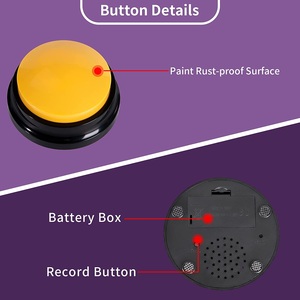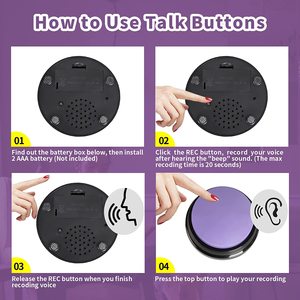
All categories
Featured selections
Trade Assurance
Buyer Central
Help Center
Get the app
Become a supplier

(8574 products available)



























Electronics button covers are essentially protective and decorative accessories used for buttons on various electronic devices. They serve both functional and aesthetic purposes. Here are some of their commonly used types:
Silicone Button Covers
These button covers are made from flexible and durable silicone rubber. They are designed to fit snugly over the buttons of various electronic devices, such as remote controls, smartphones, and game controllers. They offer a non-slip grip and protect buttons from dust, dirt, and wear. They are also available in different colors and shapes, thus allowing users to customize their devices. Silicone button covers are especially popular in gaming and remote controls.
Plastic Button Covers
These are thin, flexible covers made from durable plastic materials. Their primary purpose is to protect the buttons on electronic devices from dust, dirt, and accidental presses. They are often used on devices such as remote controls, smartphones, and game controllers. Plastic button covers can also be printed with symbols or labels. This makes it easier for users to identify the functions of different buttons. Unlike silicone button covers, plastic button covers do not provide as much grip, but they are usually more rigid and can better maintain their shape over time.
Rubber Button Covers
These are typically made from soft, flexible rubber materials. They are designed to fit over the buttons on electronic devices to protect them from dirt, dust, and wear. They are commonly used in remote controls, keyboards, and other devices with exposed buttons. Rubber button covers are also effective in preventing accidental presses of buttons. They may also come in various colors and textures, thus providing an added aesthetic appeal to devices.
Metal Button Covers
These are typically thin, durable covers made from materials like stainless steel or aluminum. Their primary function is to protect the buttons on electronic devices from wear and tear. They also add a sleek and modern look to the devices. They are often used in high-end electronics, such as smartphones, tablets, and laptops. They also come with additional benefits such as enhanced tactile feedback and increased longevity of the button mechanisms.
Custom Button Covers
These are specifically designed to fit the buttons of a particular electronic device. Their design usually incorporates unique shapes, colors, and textures that reflect the user's preferences or the device's branding. They are often used in gaming controllers, smartphones, and other gadgets to enhance usability and aesthetics. Custom button covers can also be produced using various materials such as silicone, plastic, or rubber. They also offer different levels of grip, protection, and tactile feedback.
LED Button Covers
These are specialized button covers that integrate light-emitting diodes (LEDs) into their design. They are commonly used in audio equipment, computers, and other electronic devices to provide visual indicators. These covers not only protect the buttons but also enhance the device's functionality and aesthetics by adding illumination. This makes it easier to locate and identify buttons in low-light conditions.
Some of the main design elements of an electronics button cover include the following:
Material
Material is fundamental in the design of an electronics button cover. It dictates functionality, aesthetics, and durability. Each option presents unique benefits. For instance, silicone stands out for its flexibility and grip. This makes it ideal for applications requiring a non-slip surface. Also, it offers excellent shock absorption. This protects buttons from impacts and dust. On the other hand, plastic materials like ABS are prized for their robustness and cost-effectiveness. They can be molded into complex shapes. This provides a wide range of design options. Additionally, they can be transparent. This allows for backlit buttons to shine through. Further, rubber is known for its resilience and weather resistance. This makes it suitable for outdoor devices. It also offers a soft-touch feel that enhances user comfort.
Shape and Size
Shape and size play a pivotal role in designing an electronics button cover. For instance, the cover's shape influences its ergonomic feel and aesthetic appeal. Generally, round or oval covers tend to offer a classic look. This aligns well with traditional devices. Conversely, geometric shapes like squares or rectangles provide a modern, sleek appearance. Moreover, they can complement contemporary design trends. Also, the size of the button cover is crucial for functionality and usability. It should be large enough to accommodate various button configurations. This ensures easy installation and a secure fit. At the same time, it must not be excessively big. This could impede the device's compact design or overwhelm its visual balance. Therefore, a well-designed button cover harmonizes with the device's overall design. It enhances both form and function.
Color and Texture
Color and texture significantly influence the design of electronics button covers. For instance, color choice can enhance visibility and user interaction. This makes buttons more intuitive to locate and use. Additionally, it can complement the overall aesthetic of the device. This creates a cohesive look. Moreover, texture adds a tactile dimension. This improves grip and usability. This reduces the likelihood of slips and mistakes. Further, it can convey information or status through varying textures. For example, a raised or textured cover can indicate a specific function. This provides a sensory feedback loop. Therefore, thoughtful consideration of color and texture enhances both functionality and aesthetics in electronics button cover design.
Functionality
Functionality is a critical aspect of the design of electronics button covers. It plays a pivotal role in ensuring user interaction with devices is seamless and intuitive. Typically, these covers are crafted to fit over buttons. This provides protection against dust, moisture, and wear. This prolongs the lifespan of both the buttons and the device. Also, they can be designed with varying levels of transparency. This allows for backlighting to shine through for illuminated buttons. On the other hand, they can be opaque for a more uniform appearance. Moreover, some covers include tactile feedback mechanisms. This enhances the user’s perception of button presses. As a result, they provide distinct textures or shapes. This helps users identify buttons by touch. Essentially, this is particularly useful in low-light environments or for individuals with visual impairments.
As for the wearing and matching suggestions, they will depend on the type of device buttons cover one intends to use. However, some general guidelines could help users enhance their devices' aesthetic appeal and functionality.
To wear a button cover, peel off the backing from the adhesive side and stick it onto the button. Ensure the button cover aligns with the button for a snug fit. For matching, consider contrasting colors or patterns to make the cover stand out. Alternatively, match the cover to the device's color scheme for a cohesive look.
For a remote control, choose covers that fit snugly and offer grip. Match the cover to your decor or other remotes. For a keyboard, select covers that don't obstruct typing. Match by color or theme to your keyboard or workspace. For a game controller, choose covers that enhance grip and match your gaming setup's style.
When using a phone, select a cover that complements its design and provides a secure fit. Consider a cover with a built-in screen protector for added protection. For an electronic device like a tablet or laptop, choose a cover that allows easy access to all buttons and ports. Match the cover to your device's color or finish for a seamless look.
By following these suggestions, one can effectively wear and match button covers on various electronic devices, enhancing their functionality and aesthetic appeal.
Q1: What are the benefits of using electronics button covers?
A1: The main cover protects and enhances electronic devices. It prevents accidental button presses, extends button life, and improves tactile feedback. Moreover, it can customize the device's appearance and provide a better grip.
Q2: What materials are used to make button covers?
A2: Typically, silicone, rubber, plastic, and acrylic materials are used. Silicone and rubber are preferred for their flexibility and durability. Plastic is used for its strength and cost-effectiveness. Acrylic is valued for its clarity and aesthetic appeal.
Q3: Are button covers device-specific?
A3: Yes, some button covers are universal for similar devices. However, most are designed for specific models or brands to ensure a proper fit and functionality. One should always check compatibility before purchasing.
Q4: Can a button cover be removed and reused?
A4: Most button covers can be removed without damaging the buttons or the device. However, reusability depends on the cover's quality and the adhesive used, if any. High-quality covers usually retain their shape and functionality after removal.
Q5: Do button covers affect the device's functionality?
A5: Well applied, button covers should not hinder the device's functionality. They should allow easy access and use of buttons. Poorly designed covers, however, may obstruct or make buttons difficult to press.